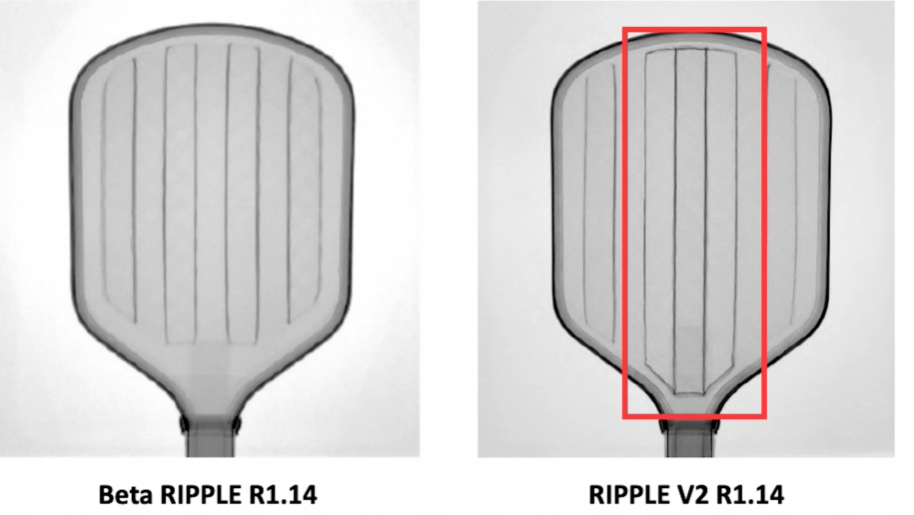Ronbus Ripple V2 Review
Hey everyone,
The Ripple V2 is finally here. It’s fully certified, available to purchase, and it doesn’t look like it’s going anywhere.
While it still carries the Ripple name, there are some key differences between this new version the V2 and the original V1 that players will want to know.
If you’re considering a premium power paddle (or just curious what makes this one different), read on for the full breakdown. Including how it stacks up against other heavy hitters and what to know before buying.
Here's everything you need to know:
What’s New – Construction, shapes, and weight
Shapes, Swing Weights, and Specs
Break in & Feel on Court
Spin, Power, Pop, and Sweet spot – Tradeoffs, strengths, weak spots, and playstyle fit
How it Compares – Ripple vs JOOLA, Paddletek, 11Six24
Is the Ripple V2 Right For You? – Ideal players and who should skip it
Final Thoughts - Is it worth it?
Price: $280
Discount Code: PBSTUDIO for $20 off
What’s New: Construction, Shapes, and Weight
The Ripple V2 may share a name with the original V1 , but it’s a very different paddle. Especially when it comes to construction and feel.
Ronbus added a number of structural changes aimed at improving both performance and durability, starting off with:
EVA Foam Core: Similar in concept to paddles like the Gearbox or Adidas Metalbone. The soft foam designed to reduce vibration and create pop.
Vertical Carbon Fiber Ribs: These run up and down the paddle face to stiffen the core and help it pass certification.
Extra Carbon Through the Center: Added to increase long-term durability and reduce the chance of early breakdown.
Carbon Grid Wrap: A woven carbon outer layer surrounds the internal components to add structure and stiffness.
All of this reinforcement adds weight especially toward the top of the paddle which significantly bumps up the swing weight across the lineup.
Shapes, Swing Weights & What to Know
What Know About Each Model
At launch, the Ripple V2 comes in three shapes:
R1 – Elongated (Good plow through, heavy, tight sweet spot)
Swing weight: 126 (which is very high)
Very head-heavy, tons of plow-through.
But: it’s less stable, has a tighter sweet spot, and is slower in the hands.
If you’re going to choose the R1, it probably means you’re someone who prefers a head-heavy paddle that can plow through the ball. If you're looking for something light, this is absolutely not it.
R2 – Widebody (Big sweet spot, stable, but slow for a wide body)
Swing weight: 116–119, which is heavy for a widebody (most hover around 107–112).
Has the largest sweet spot and most stability.
But: it’s not especially fast so you lose the hand speed typically associated with widebody shapes.
That may be a pretty big downside... a lot of times widebody paddles are very quick in the hand, and that’s a big part of their appeal.
R4 – Hybrid (My Recommendation)
Same swing weight range as the R2, but feels more manageable because it is closer to the standard swing weight range of hybrid paddles.
A good middle ground: still powerful, not as sluggish as the R1, and not as bulky-feeling as the R2.
From a hand speed perspective, I think the R4 is going to be the one I recommend the most. I think that is going to be the most popular one of the bunch.
TL;DR — What I Think
Both the R1 and R2 ended up heavier than typical paddles in their categories. That might be fine for some players, but for most, especially if you’re not used to high swing weights, the R4 just makes the most sense.
If you want the Ripple experience without committing to a paddle that feels too slow or too head-heavy, the R4 is the way to go.
Specs
R1 – Elongated
Shape: Elongated
Swing Weight: 123–126
Twist Weight: 5.66
Handle: 5.5”
Grip: 4.125”
Thickness: 14mm
RPM: 1999
Warranty: 6 months
R2 – Widebody
Shape: Widebody
Swing Weight: 116–119
Twist Weight: 6.53
Handle: 5.5”
Grip: 4.125”
Thickness: 14mm
RPM: 1940
Warranty: 6 months
R4 – Hybrid
Shape: Hybrid
Swing Weight: 116–119
Twist Weight: 5.73
Handle: 5.5”
Grip: 4.125”
Thickness: 14mm
RPM: 1873
Warranty: 6 months
Break In & Feel on Court
There’s a lot to like about the Ripple V2’s performance, but the feel is where things get interesting and a little nuanced.
Right out of the box, the paddle felt stiff and a little tingy, especially in the center.
After about 10 hours of play, that stiffness started to fade and the paddle felt noticeably softer and more comfortable on contact.
It never felt like it was “heating up” or gaining power just breaking in naturally over time.
Spin, Power, Pop, and Sweet Spot
Spin
This is where things took a bit of a step back compared to the original prototypes.
Those early units were pulling 2300–2400 RPM, which was wild.
On the Ripple V2, I was seeing high 1900s across the board which is solid, but not standout.
I felt it most when going for aggressive topspin shots. I just didn’t get quite enough dip to keep the ball in consistently. I felt that paddles like the TruFoam Genesis, could shape the ball a bit better.
I also think the reduced dwell time on this paddle plays a role. The ball doesn’t stay on the face as long as it did with earlier Ripples, so you lose a bit of grip and spin potential.
Just keep in mind that the Ripple might work better for certain swing styles. It’s possible that my swing mechanics just don’t bring out the best spin with this paddle. Other players might find the spin totally fine, but for me, the spin didn’t really stand out.
Pop & Power
This is where the Ripple shines:
Top-tier power — could be compared with the best of the best.
Muted sound — but the ball jumps off the face.
Huge pop on counters — great for blocking and punch volleys.
On resets, if you’re the type of player who likes to just hold the paddle out and let it do the work, the Ripple rewards that style.
But if you tend to add a little swing on resets (like I do) the pop can get away from you and push the ball a little too far.
Control & Sweet Spot
This is where the tradeoffs start to show.
The sweet spot is tight, and when you miss it, you’ll feel it.
Off-center hits don’t get much help, and there’s not much room to customize the paddle since it’s already heavy.
I found myself having to play more aggressively just to avoid being stuck in touch-and-go resets.
How It Compares: Ripple V2 vs. the Field
Here’s how the Ripple stacks up next to some of the other top-tier power paddles I’ve tested, not just on paper, but in how they actually feel to play with.
JOOLA Pro 4
Probably the Ripple’s closest direct competitor
Available in 14mm (poppier) and 16mm (softer) models
Much better sweet spot and more consistent overall
In head-to-head play, I just trusted it more under pressure
If you want more forgiveness and control, the JOOLA is probably the safer pick.
11Six24 Power Series
~$100 cheaper
Lighter, easier to swing, easier to control
Still brings solid pop and power
Best for players who want something in the middle-ground
It’s a great paddle if you want to hit hard, but not sacrifice all your control.
Paddletek Bantam
Smaller sweet spot, but a more consistent feel
Super durable and built to last and backed by a lifetime warranty
Doesn’t hit as hard as the Ripple, but still has great pop
If you’re rough on your paddles or want something dependable for the long haul, the Bantam is worth a look.
Quick Recap
JOOLA Pro 4 → Safer, more forgiving, easier to trust in tight games
11Six24 → Lighter, cheaper, still punchy, and a solid all-arounder
Paddletek Bantam → Not flashy, but durable with consistent play.
The Ripple V2?
It’s the most aggressive paddle in this group. Built for players who want to swing big, block hard, and let the paddle do the work. But with that comes a tight sweet spot and heavier feel, so if you’re not used to that kind of paddle, there may be a learning curve.
If you’re after power with precision, and you’ve got the mechanics to back it up the Ripple’s could be the option.
Is the Ripple V2 Right for You?
The conversation about the Ripple isn’t if it’s a good paddle or not, but rather if the Ripple V2 offers something other paddles don’t.
The Ripple V2 isn’t trying to be the most forgiving or versatile paddle out there and that’s the point. It’s built with a clear player in mind.
✅ Best Suited For:
Advanced players who can handle a smaller sweet spot
Former tennis players used to head-heavy rackets
Power-focused styles: bangers, counter-punchers, and blockers
Players who like a muted, dampened feel with tons of pop off the face
If you like to let the paddle do the work during punching volleys, blocking attacks, or ripping hard drives, the Ripple rewards that kind of game.
❌ Not the Best Fit If:
You rely on quick hands and reflex counters at the kitchen
You want a bigger sweet spot or room to tinker with lead tape
You’re sensitive to heavy swing weight or don’t like soft-feeling handles
Final Thoughts
The Ronbus Ripple V2 delivers big-time power with equally big expectations.
It hits like a truck, has top-tier pop, and gives aggressive players a real weapon, but it’s not going to forgive sloppy mechanics or off-center hits. If you’re confident in your timing and used to heavier paddles, this could absolutely be your next go-to.
But if you’re still developing your touch game or prefer something a little quicker and more forgiving? There are other paddles in the lineup better suited to that.
Use code PBSTUDIO for $20 off your order at Ronbus.com







